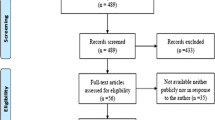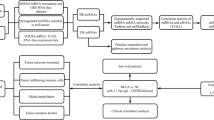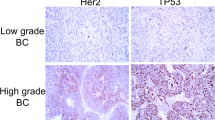Abstract
Despite the association of several miRNAs with bladder cancer, little is known about the miRNAs’ regulatory networks. In this study, we aimed to construct potential networks of bladder-cancer-related miRNAs and their known target genes using miRNA expression profiling and bioinformatics tools and to investigate potential key molecules that might play roles in bladder cancer regulatory networks. Global miRNA expression profiles were obtained using microarray followed by RT-qPCR validation using two randomly selected miRNAs. Known targets of deregulated miRNAs were utilized using DIANA-TarBase database v6.0. The incorporation of deregulated miRNAs and target genes into KEGG pathways were utilized using DIANA-mirPath software. To construct potential miRNA regulatory networks, the overlapping parts of three selected KEGG pathways were visualized by Cytoscape software. We finally gained 19 deregulated miRNAs, including 5 ups- and 14 down regulated in 27 bladder-cancer tissue samples and 8 normal urothelial tissue samples. The enrichment results of deregulated miRNAs and known target genes showed that most pathways were related to cancer or cell signaling pathways. We determined the hub CDK6, BCL2, E2F3, PTEN, MYC, RB, and ERBB3 target genes and hub hsa-let-7c, hsa-miR-195-5p, hsa-miR-141-3p, hsa-miR-26a-5p, hsa-miR-23b-3p, and hsa-miR-125b-5p miRNAs of the constructed networks. These findings provide new insights into the bladder cancer regulatory networks and give us a hypothesis that hsa-let-7c, hsa-miR-195-5p, and hsa-miR-125b-5p, along with CDK4 and CDK6 genes might exist in the same bladder cancer pathway. Particularly, hub miRNAs and genes might be potential biomarkers for bladder cancer clinics.


Similar content being viewed by others
References
Ferlay J, Soerjomataram I, Ervik M, Dikshit R, Eser S, Mathers C, Rebelo M, Parkin DM, Forman D, Bray, F (2013) GLOBOCAN 2012 v1.0, Cancer incidence and mortality worldwide: IARC cancerbase No. 11 Lyon, France: international agency for research on cancer. Available from: http://globocan.iarc.fr, accessed on 04/06/2014.
Taioli E, Raimondi S (2005) Genetic susceptibility to bladder cancer. Lancet 366:610–612
Clapp RW, Jacobs MM, Loechler EL (2008) Environmental and occupational causes of cancer: new evidence 2005-2007. Rev Environ Health 23:1–37
Garzon R, Marcucci G, Croce CM (2010) Targeting microRNAs in cancer: rationale, strategies and challenges. Nat Rev Drug Discov 9:775–789
Visone R, Croce CM (2009) MiRNAs and cancer. Am J Pathol 174:1131
Esquela-Kerscher A, Slack FJ (2006) Oncomirs—microRNAs with a role in cancer. Nat Rev Cancer 6:259–269
Chen YH et al (2013) Characterization of microRNAs expression profiling in one group of Chinese urothelial cell carcinoma identified by Solexa sequencing. Urol Oncol 31:219–227
Dyrskjøt L et al (2009) Genomic profiling of microRNAs in bladder cancer: miR-129 is associated with poor outcome and promotes cell death in vitro. Cancer Res 69:4851–4860
Han Y et al (2011) MicroRNA expression signatures of bladder cancer revealed by deep sequencing. PLoS ONE 6:e18286
Puerta-Gil P, Garcia-Baquero R, Jia AY, Ocana S, Alvarez-Mugica M, Alvarez-Ossorio JL, Cordon-Cardo C, Cava F, Sanchez-Carbayo M (2012) miR-143, miR-222, and miR-452 are useful as tumor stratification and noninvasive diagnostic biomarkers for bladder cancer. Am J Pathol 180:1808–1815
Rosenberg E, Baniel J, Spector Y, Faerman A, Meiri E, Aharonov R, Margel D, Goren Y, Nativ O (2013) Predicting progression of bladder urothelial carcinoma using microRNA expression. BJU Int 112(7):1027–1034
Wang S, Hu J, Zhang D, Li J, Fei Q, Sun Y (2014) Prognostic role of microRNA-31 in various cancers: a meta-analysis.Tumour Biol. [Epub ahead of print]
Fu W, Pang L, Chen Y, Yang L, Zhu J, Wei Y (2014) The MicroRNAs as prognostic biomarkers for survival in esophageal cancer: a meta-analysis. Sci World J. 2014: 523979. Epub 2014 Jul 6. Review.
Vergoulis T, Vlachos IS, Alexiou P, , Georgakilas G, , Maragkakis M, Reczko M, Gerangelos S, Koziris N, Dalamagas T, Hatzigeorgiou AG (2012) Tarbase 6.0: capturing the exponential growth of miRNA targets with experimental support. Nucl Acids Res 40(D1):D222–D229. doi:10.1093/nar/gkr1161
Vlachos IS, Kostoulas N, Vergoulis T, Georgakilas G, Reczko M, Maragkakis M, Paraskevopoulou MD, Prionidis K, Dalamagas T, Hatzigeorgiou AG (2012) DIANA miRPath v.2.0: investigating the combinatorial effect of microRNAs in pathways nucleic acids research (Web server issue)
Shannon P, Markiel A, Ozier O, Baliga NS, Wang JT, Ramage D, Amin N, Schwikowski B, Ideker T (2003) Cytoscape: a software environment for integrated models of biomolecular interaction networks. Genome Res 13:2498–2504
Benjamini Y, Hochberg Y (1995) Controlling the false discovery rate: a practical and powerful approach to multiple testing. J R Stat Soc Series B Stat Methodol 57:289–300
Yoshino H, Seki N, Itesako T, Chiyomaru T, Nakagawa M (2013) Enokida H (2013) Aberrant expression of microRNAs in bladder cancer. Nat Rev Urol 10(7):396–404. doi:10.1038/nrurol.2013.113.Epub.Review
Guancial EA, Bellmunt J, Yeh S, Rosenberg JE, Berman DM (2014) The evolving understanding of microRNA in bladder cancer. UrolOncol 32(1):e31–e40. doi:10.1016/j.urolonc.2013.04.014 Epub 2013 Aug 2
http://www.kegg.jp/kegg-bin/search_pathway_text?map=map&keyword=cancer&mode=1&viewImage=true
Abdollahi A, Schwager C, Kleeff J, Esposito I, Domhan S, Peschke P, Hauser K, Hahnfeldt P, Hlatky L, Debus J, Peters JM, Friess H, Folkman J, Huber PE (2007) Transcriptional network governing the angiogenic switch in human pancreatic cancer. Proc Natl Acad Sci USA 104(31):12890–12895 Epub 2007 Jul 24
Horvath S, Zhang B, Carlson M, Lu KV, Zhu S, Felciano RM, Laurance MF, Zhao W, Qi S, Chen Z, Lee Y, Scheck AC, Liau LM, Wu H, Geschwind DH, Febbo PG, Kornblum HI, Cloughesy TF, Nelson SF, Mischel PS (2006) Analysis of oncogenic signaling networks in glioblastoma identifies ASPM as a molecular target. Proc Natl Acad Sci USA 103(46):17402–17407 Epub 2006 Nov 7
Castillo-Martin M, Domingo-Domenech J, Karni-Schmidt O, Matos T, Cordon-Cardo C (2010) Molecular pathways of urothelial development and bladder tumorigenesis. UrolOncol 28(4): 401–8. doi: 10.1016/j.urolonc.2009.04.019. Review.
Sfakianos JP, Lin Gellert L, Maschino A, Gotto GT, Kim PH, Al-Ahmadie H, Bochner BH (2014) The role of PTEN tumor suppressor pathway staining in carcinoma in situ of the bladder. UrolOncol S1078–1439(14):00034–00039. doi:10.1016/j.urolonc.2014.02.003 Epub ahead of print
Olsson AY, Feber A, Edwards S, TePoele R, Giddings I, Merson S, Cooper CS (2007) Role of E2F3 expression in modulating cellular proliferation rate in human bladder and prostate cancer cells. Oncogene 26(7):1028–1037 Epub 2006 Aug 14
Huang L, Luo J, Cai Q, Pan Q, Zeng H, Guo Z, Dong W, Huang J, Lin T (2011) MicroRNA-125b suppresses the development of bladder cancer by targeting E2F3. Int J Cancer 128(8):1758–1769. doi:10.1002/ijc.25509
Wu XR (2005) Urothelial tumorigenesis: a tale of divergent pathways. Nat Rev Cancer 5(9):713–725
Wang G, Zheng L, Yu Z, Liao G, Lu L, Xu R, Zhao Z, Chen G (2012) Increased cyclin-dependent kinase 6 expression in bladder cancer. Oncol Lett 4(1):43–46 Epub 2012 Apr 25
Lin Y, Wu J, Chen H, Mao Y, Liu Y, Mao Q, Yang K, Zheng X, Xie L (2012) Cyclin-dependent kinase 4 is a novel target in micoRNA-195-mediated cell cycle arrest in bladder cancer cells. FEBS Lett 586(4):442–447. doi:10.1016/j.febslet.2012.01.027 Epub
Acknowledgments
This research was supported by the Eskisehir Osmangazi University Research Fund with Grant no. 200811031. We are also thankful to Ece TURKMEN, the Product Manager at SEM Laboratuar Cihazlari Paz. San. Tic. A. S, (Istanbul-Turkey), who provided facilities to carry out this study.
Author information
Authors and Affiliations
Corresponding author
Rights and permissions
About this article
Cite this article
Canturk, K.M., Ozdemir, M., Can, C. et al. Investigation of key miRNAs and target genes in bladder cancer using miRNA profiling and bioinformatic tools. Mol Biol Rep 41, 8127–8135 (2014). https://doi.org/10.1007/s11033-014-3713-5
Received:
Accepted:
Published:
Issue Date:
DOI: https://doi.org/10.1007/s11033-014-3713-5




